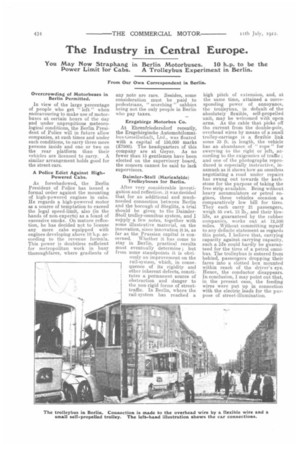The Industry in Central Europe.
Page 18

If you've noticed an error in this article please click here to report it so we can fix it.
You May Now Straphang in Berlin Motorbuses. 10 h.p. to be the Power Limit for Cabs. A Trolleybus Experiment in Berlin.
From Our Own Correspondent in Berlin.
Overcrowding of Motorbuses in Berlin Permitted.
in view of the large percentage of people who get " left " when endeavouring to make use of motorbuses at certain hours of the day and under unpropitious meteorological conditions? the Berlin President of .Police will in future allow companies, at such times and under such conditions, to carry three more persons inside and one or two on the rear platform than their vehicles are licensed to carry. A similar arrangement holds good for the street cars.
A Police Edict Against High. Powered Cabs.
As foreshadowed, the Berlin President of Police has issued a formal order against the mounting of high-powered engines in cabs. He regards a high-powered motor as a source of temptation to exceed the legal speed-limit, also (in the hands of non-experts) as a fount of excessive smoke. On mature reflection, he has decided not to license any more cabs equipped with engines developing above 10 h.p. according to the revenue formula. This power is doubtless sufficient for metropolitan work in busy thoroughfares, where gradients of any note are rare. Besides,. some consideration must be paid to pedestrians, " scorching ". cabbies being not the only people in Berlin who pay taxes.
Erzgebirge Motorbus Co.
At Ehrenfriedersdorf recently, the Erzgebirgische Automobilomnibus-Gesellschaf t, Ltd., was floated with a capital of 150,000 marks (£7500). The headquarters of this company are at Geyer. As no fewer than 15 gentlemen have been elected on the supervisory board, the concern cannot be said to lack supervisors.
Daimler-Stoll (Marienfelde) Trolleybuses for Berlin.
After very considerable investigation and reflection, it was decided that for an additional and muchneeded connection between Berlin and the borough of Steglitz, a trial should be given to the DaimlerStoll trolley-omnibus system, and I supply a few notes, together with some illustrative material, on the innovation, since innovation it is, as far as the Prussian capital is concerned. Whether it has come to stay in Berlin, practical results must eventually determine ; but from some standpoints it is obviously an improvement on the rail-system, which, in consequence of its rigidity and other inherent defects, constitutes a permanent source of obstruction and danger to the non-rigid forms of streettraffic. In Berlin, where the rail-system has reached a
high pitch of extension, and, at the same time, attained a. corresponding power of annoyance, the trolleybus, in default of the absolutely flexible, self-propelled unit, may be welcomed with open arms. As the cable that picks off the current from the double-pole, overhead wires by means of a small trolley-carriage is a flexible link some 33 ft. in length, the vehicle has an abundance of " rope " for swerving to the right or left, according to the exigencies of traffic ; and one of the photographs reproduced is especially instructive, inasmuch as it shows how an omnibus negotiating a road under repairs has swung out towards the kerbstone for the purpose of taking the free strip available. Being without heavy accumulators or petrol engines, these vehicles occasion a comparatively low bill for tires. They each carry 21 passengers, weigh 55 cwt. 13 lb., and their tirelife, as .guaranteed by the rubber companies, works out at 12,500 miles. Without committing myself to any definite statement as regards this point, I believe that, carrying capacity against carrying capacity, such a life could hardly be guaranteed for the tires of a petrol omnibus. The trolleybus is entered from behind, passengers dropping their fares into a slotted box mounted within reach of the driver's eye. Hence, the conductor disappears. In conclusion, I may point out that, in the present case, the feeding wires were put up in connection with the electric leads for the purpose of street-illumination.






















